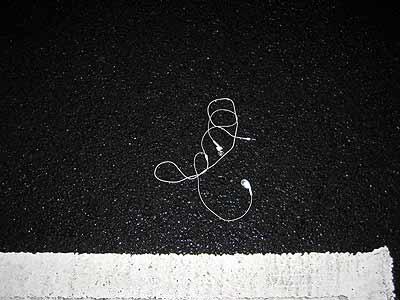I'm very glad to have reached the weekend, even if I have to get on a plane later today. There are least two very nice things indeed to look forward to in the next couple of days: Catherine Bott singing me some great songs, and then the two of us performing them on stage with Shirley Collins for company. Now those are well worth getting on a plane for, especially as I've no intentions of going anywhere near Heathrow Terminal 5, or any other of its terminals for that matter - I decided some time ago that Heathrow airport was such a hideous experience that I would do my utmost never to encounter it at close quarters again.
Stephen Duffy spotted this sad sight in the BBC car park on Wednesday night: someone's iPod headphones had suffered a cruel death under a car tyre or two.

Pamela came over on Thursday afternoon (does coming from York count as 'over'? not really), and despite the fact that we were both a bit sleepy - I'd nodded off in my Alexander lesson that morning for the first time ever - we worked our way through a large pile of possible repertoire, including the accompanied pieces from Duphly's 3rd book of Pièces de clavecin, which I remembered I had in the attic. But first I had to pass my Stylophone Garage Band recording audition. Anyway, if you're still following this paragraph, one of the difficulties of programming obscure but beautiful chamber music is finding a way to include the pieces you want to play, and which you know the audience will love, while simultaneously giving the impression that the concert is really full of music by composers that people have heard of: music that they will actually buy tickets to come and hear. A certain amount of gentle deception is required.
Yesterday I dropped in on Barnaby Brown to eat and talk about some shared research interests, and one idea that popped out was something that Chris Wood had brought up at distil a couple of weeks ago. He was saying that when musical traditions become too dependent on collectivity (like the ubiquitous folk music sessions) the music starts to become uniform and sacrifices a lot of its individuality. So for example, Scottish fiddle tunes are now almost always in two parts, an A and a B, each 8 bars long. Where you have a tradition that still involves people developing things on their own, the results are more diverse, or to use the fiddle tune term, crooked. Barnaby was showing me evidence of the same in early pibroch and early harp music, and I was finding it very interesting indeed. Similarly, as I heard Martin Carthy say some time ago: 'All folk songs are in 1'. Dolly Collins's arrangements are beautifully asymmetrical. Discovering that even the most regimented of Scottish traditional music hasn't always been so foursquare is quite liberating.
